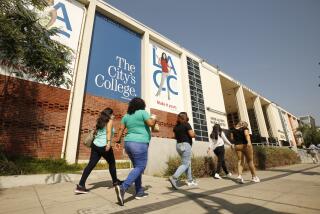Community colleges must commit to change
Californiaâs community colleges were envisioned by the stateâs Master Plan for Higher Education as a low-cost alternative for students to complete the first two years of college before transferring to a four-year school. They were also designed for students whose ultimate educational goal was to attain an associateâs degree or career certification.
But a report issued last week calls into question the success of those missions.
The report, issued by the Institute for Higher Education Leadership & Policy at Cal State Sacramento, documents abysmally low student transfer and completion rates at the stateâs community colleges. Following the academic careers of 250,000 first-time students from 2003 through 2009, the institute found that only one-third of them had gotten any credential â a certificate, associateâs degree or transfer to a four-year university â to show for their time in class. Of the students who started out with the intention of transferring to a University of California or Cal State school, just 23% had made the jump six years later. Transfer rates for Latino and black students were even worse. Only 14% of Latino students and 20% of African American students successfully made the move to a four-year college.
The Student Transfer Achievement Reform Act, signed in September by Gov. Arnold Schwarzenegger, promises to improve transfer rates. Under the law, if a student completes 60 units and earns at least a C average, he or she will be guaranteed admission as a junior to a Cal State campus. But itâs not clear that the law alone is enough, especially for Latino and black students, who make up 40% of the community college population.
The instituteâs report urges community colleges to collect data on their studentsâ class choices and progress in them. It also encourages the schools to break down the results by race and ethnicity. Community colleges seldom employ this kind of analysis. But âdisaggregatingâ the data, as the method is called, yields a finer-grained picture of how Latinos and blacks are performing in class. Equally important, it helps educators identify institutional or instructional practices that may be contributing to the low transfer rates of these students.
Some community colleges have already taken this essential step and designed responses to the problems the data analysis unearthed. And from their experience, it is clear that in order to address the issues, the entire community college â administrators, faculty and counselors â must commit itself to change. Locally, Los Angeles Southwest College and Long Beach City College have already embraced such a commitment.
In 2008, L.A. Southwest College looked at what was going on in its basic-skills math classes, where most community college students begin their studies. It found that from fall 2002 to spring 2007, only 13% of its black students who enrolled in basic-skills math went on to college-level math. The performance of its Latino students was better but not satisfying: 32% of English-learners had progressed from basic math to college math.
Southwest College used these findings, which are typical for many urban colleges, to make some important changes in its institutional practices. Learning support services for students were beefed up. Math teachers moved their student advising hours from their offices to the schoolâs math labs. Tutoring focused on the content of math courses, and lab hours were added to each of the basic-skills math courses.
Long Beach City College also analyzed its student data by race and ethnicity to find out who was successfully transferring. After examining thousands of records of first-time students enrolled between 1999 and 2005, it discovered that a large number of students, including many blacks and Latinos, had dropped out when they were only one or two courses short of being eligible for transfer. One reason: The college concluded that students hadnât received enough help or information to complete the transfer process or qualify for financial aid.
In response, the collegeâs website now features information on transfer requirements and procedures, and a transfer academy was established to speed up the paperwork involved in moving from a community college to a four-year school. The school has committed itself to monitoring the transfer rates of black and Latino students to see how the changes are working.
Institutional self-scrutiny is not a pain-free experience, as L.A. Southwest and Long Beach City will surely attest. But both colleges mustered the institutional courage to face up to their unacceptable success rates for Latino and black students. They then united as an institution behind the changes needed to address the problem. Though itâs too early to gauge the effectiveness of their institutional changes â typically, it takes three to six years to track changes in transfer rates â the colleges are now in a position to recognize problems as they are developing and intervene while there is still time to help students transfer to four-year institutions.
Administrators, faculty and counselors at many community colleges are now being trained to do the kind of data analysis that L.A. Southwest and Long Beach have used. They are also learning how to combine their efforts to produce institution-wide change. Their experiences and knowledge should inform the community collegesâ board of governors, which, under another law signed by Schwarzenegger, will devise a plan in two years to improve community college student transfer and completion rates.
The result may lead to a true milestone in California higher education â more Latinos and black students earning associate degrees and transferring to four-year schools.
Estela Mara Bensimon and Alicia C. Dowd are co-directors, and Linda J. Wong is executive director, of the Center for Urban Education at the University of Southern California.
More to Read
Sign up for Essential California
The most important California stories and recommendations in your inbox every morning.
You may occasionally receive promotional content from the Los Angeles Times.










